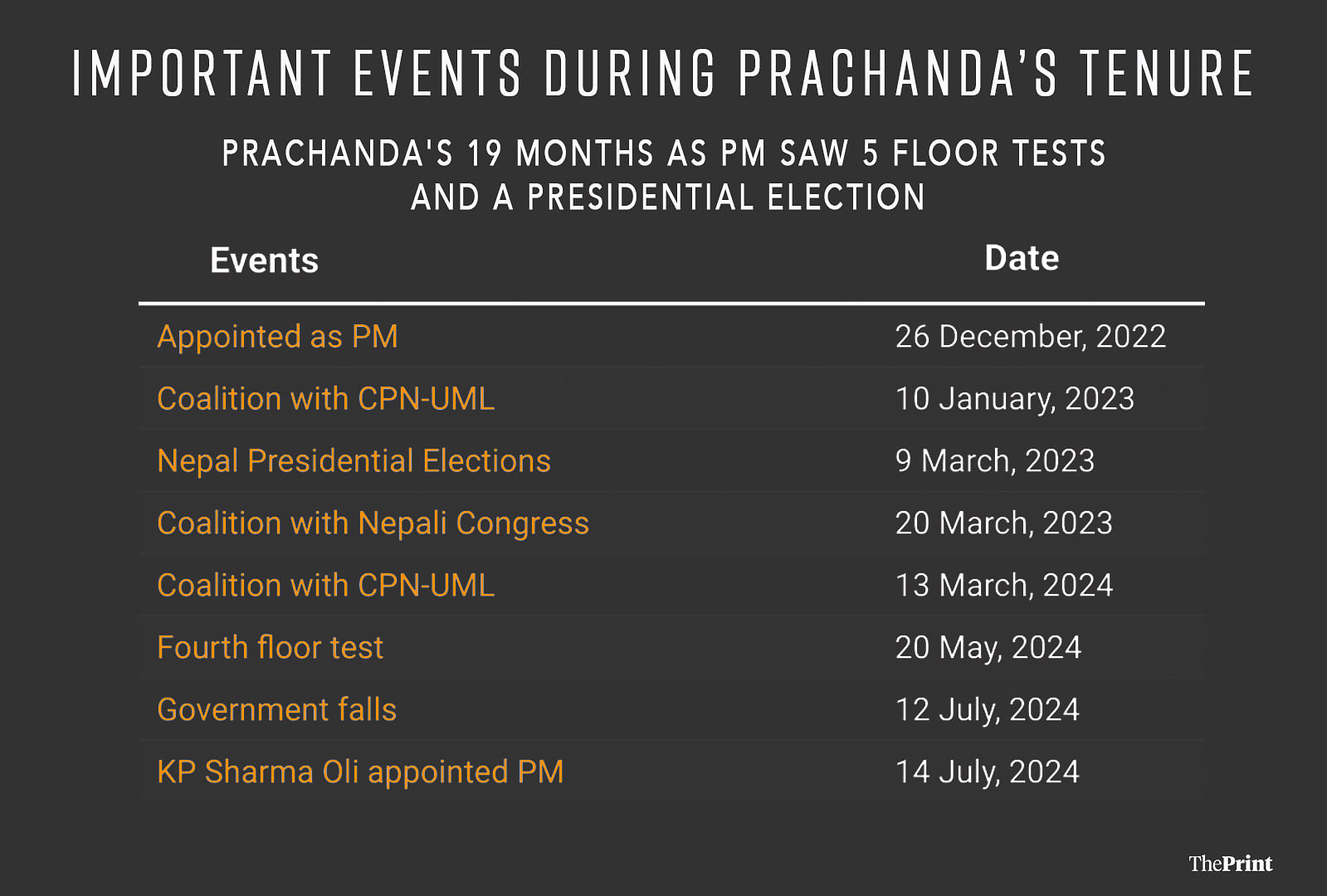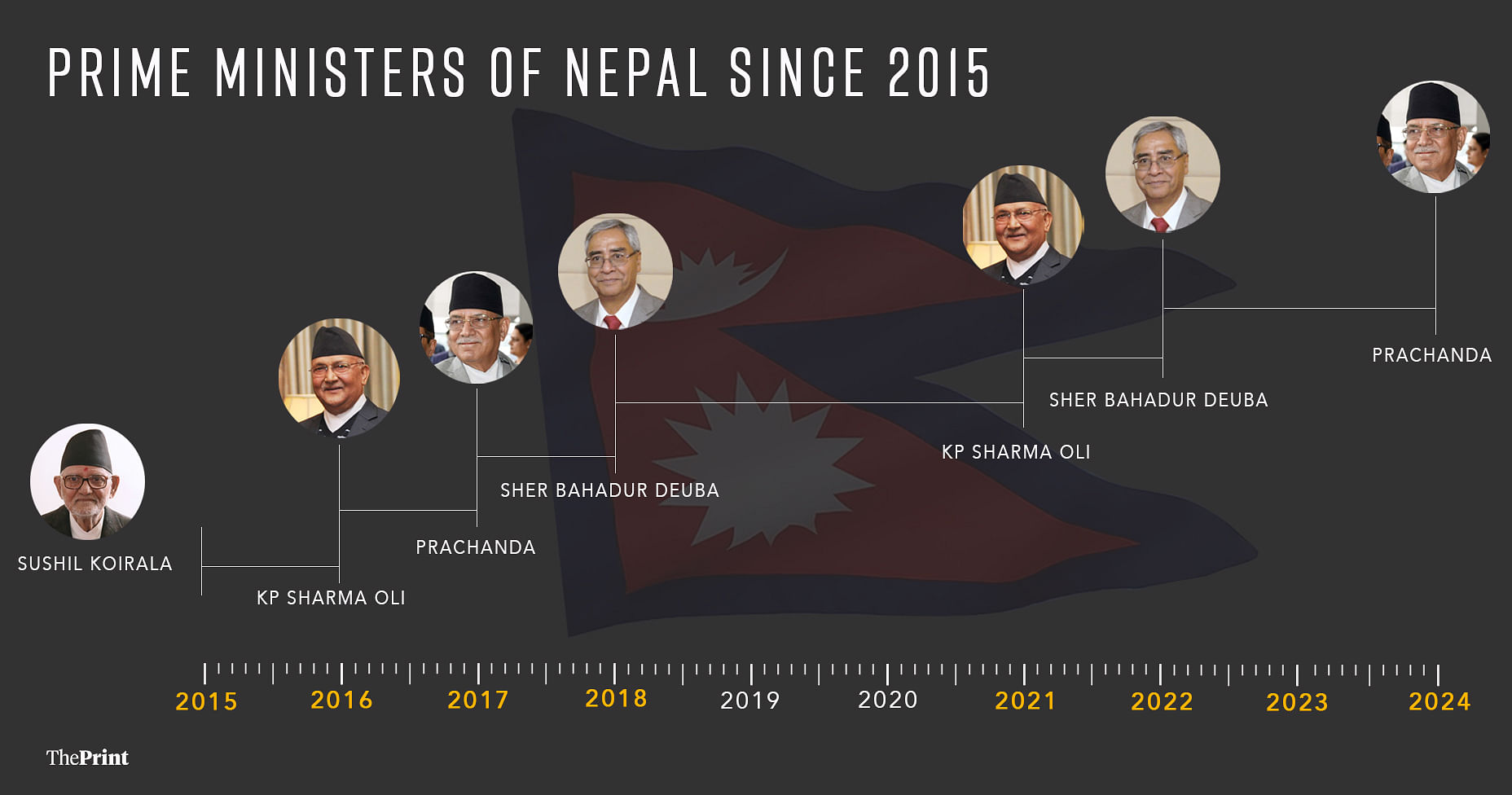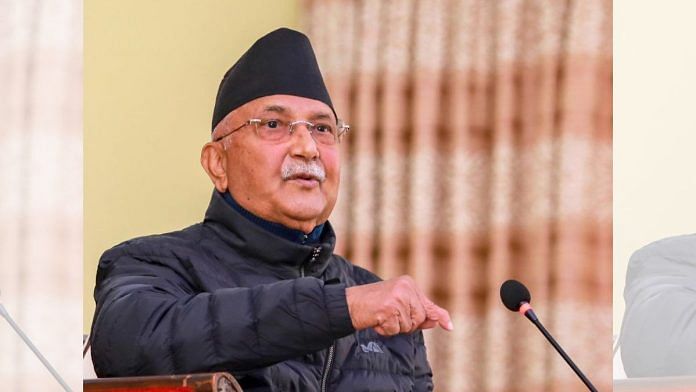New Delhi: Khadga Prasad Sharma Oli will take oath as Prime Minister of Nepal for the third time Monday since 2015, after the incumbent leader Pushpa Kamal Dahal (Prachanda) failed to secure a majority Friday in the House of Representatives.
Prachanda’s call for a floor test was his fifth since assuming the post in December 2022 — a mere 19 months before Friday’s test. The one constant of Nepalese politics since the country became a Republic in 2008, is the revolving door of prime ministers. Oli will be sworn as the 13th prime minister of the country in 16 years.
In this instance, Oli’s Communist Party of Nepal (Unified Marxist-Leninist), or CPN-UML, has stitched together a coalition with the Nepali Congress (NC). The two parties are the largest in the House of Representatives following the 2022 Nepalese general elections.
The NC, led by five-time former PM Sher Bahadur Deuba, won the most number of seats in the 2022 elections at 89, while Oli’s CPN-UML finished second with 78 seats. Prachanda’s Communist Party of Nepal Maoist Centre (CPN-MC), finished third with 32 seats.
Prachanda, however, was able to stitch together coalitions with both Oli and Deuba at different times to maintain his grip of power. All of his deft dealings with the two largest parties, though, crumbled on 1 July, when the CPN-UML and NC announced a power-sharing agreement.
Oli at the time had been in a coalition with Prachanda, which on 20 March, 2024, faced its floor test — the third of Prachanda’s term.
The total strength of the Nepalese House of Representatives is 275, with 165 seats elected by first past the post system, while the remaining 110 seats are elected by proportional representation. The two parties have agreed to amend the constitution to potentially change the method of electing representatives, while the modalities of the same have been finalised, according to local media reports.
The new government will be led by Oli for 18 months before Deuba takes over for the sixth time as the Prime Minister of Nepal till the next general elections scheduled for 2027. However, faith in such an agreement lasting is little, given the musical chairs of Nepalese politics.
Also read: Kathmandu-Kerung railway, airports & more—Chinese aid can cost Nepal and its ties with India
Prachanda’s four lives
Prachanda, which means “The Fierce One”, protected his stay at Baluwatar — the residence of the Prime Minister — between December 2022 and July 2024.
Before entering domestic politics, Prachanda led the Maoists in the decade long Nepalese civil war between 1996 until the signing of the Comprehensive Peace Accord (CPA) in November 2006. The agreement bears the signature of Prachanda and Girija Prasad Koirala — the then PM from the Nepali Congress.
In August 2008, Prachanda came to power as prime minister for the first time. However, his tenure ended in May 2009. Months before his first term, Nepal had abolished the monarchy and the last King Gyanendra, accepted the declaration of the Himalayan country as a Republic, led by a president.
Prachanda’s government, however, fell after a row over sacking of the chief of the army at the time. The CPN-UML leader at the time, Madhav Kumar Nepal, was able to become the next prime minister of the country.

The Fierce One, however, returned to power for a second time between August 2016 and June 2017. His third and most recent time as Prime Minister lasted longer than his previous two tenures — from 26 December 2022 till 14 July 2024, his longest till date.
However, his tenure is indicative of the political uncertainty that comes with taking residence at Baluwatar. Dahal faced five floor tests, winning four and losing the latest one held Friday.
His first floor test was conducted on 10 January, 2023, where he received 268 votes. Prachanda, at the time, was in coalition with Oli’s CPN-UML along with a myriad of other smaller parties.
The coalition, though, fell after Prachanda was perceived as getting too close to Deuba, and the PM chose to support Ram Chandra Paudel from the NC as the next president of the country in March 2023.
This led to the Maoist leader facing his second floor test on 20 March, 2023. He stitched together a coalition with Deuba and remained in power. The CPN-MC and NC coalition survived till February 2024.
On 4 March 2024, Prachanda broke with the NC and joined hands with Oli and CPN-UML for a second time. On 13 March, 2024, the CPN-MC and CPN-UML coalition, supported by smaller parties, were able to pass the floor test, with 157 votes in favour.
In May of this year, the Nepalese PM was forced into his fourth floor test, after a smaller partner — Janata Samajbadi Party — split. Prachanda was able to survive this test as well, till both Oli and Deuba decided to come together, once again leading to uncertainty in Kathmandu.
Revolving door of PMs
Prachanda’s coalitions and deals to maintain power in the Himalayan country of 30 million people is not a surprise since the country became a democratic Presidential republic in 2008.
At the end of Prachanda’s first term as Prime Minister in 2009, the CPN-UML led by Madhav Kumar Nepal quickly stepped in to lead the country. Little over a year later in February 2011, Nepal resigned following a deadlock within the Constituent Assembly. He was replaced by Jhalanath Khanal, who survived in his position for about seven months.
Baburam Bhattarai, returned the Maoists to power in August 2011, with a promise to break the deadlock within the Constituent Assembly of the country, especially over the integration of Maoist guerilla fighters with the Nepalese Army. In August 2013, some of the former Maoist fighters joined the Nepalese Army.
Bhattarai, eventually resigned to make way for the Chief Justice of Nepal Khil Raj Regmi, to lead a caretaker government until elections to a second Constituent Assembly would be held. However, the November 2013 elections once again threw up a hung assembly, leading to political wrangling among the various parties.
Eventually in February 2014, Sushil Koirala from the Nepali Congress, was able to form a majority and with that was appointed as the prime minister of Nepal, as the sixth leader of the country in six years.
Koirala was able to survive till October 2015, when he resigned after protests in the country, as well as a diplomatic standoff with India over its new constitution, especially on the issue of representation of Madhesi people and Tharu peoples.

Between the resignation of Koirala in October 2015 and February 2018, Kathmandu witnessed four prime ministers — Oli, Prachanda, Deuba and Oli.
Oli’s second tenure as the leader of the country lasted over three years till May 2021, while Deuba’s NC remained in opposition.
Between 2018 and 2021, the two CPN’s led by Oli and Prachanda had unified as the Nepal Communist Party (NCP). A few decisions taken by Oli were declared invalid by the Supreme Court, including the dissolution of the House, and the foundation of the NCP. The dissolution of the NCP led to both CPN-UML and CPN-MC reforming.
Eventually in July 2021, Deuba returned to Baluwatar and remained PM till December 2022, when Prachanda returned as the leader of the country after the elections, capping 13 different leaders since 2008, including the Chief Justice of the Supreme Court stepping in as an interim PM.
(Edited by Zinnia Ray Chaudhuri)
Also read: ‘Same as BJP’ in ideology, Nepal Janata Party works to expand — ‘will make Nepal Hindu Rashtra’






